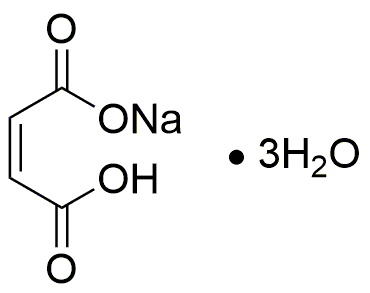Monosodium maleate trihydrate is widely utilized in research focused on:
- Food Industry: It serves as a food additive, enhancing flavor and stability in various processed foods, making it a popular choice for manufacturers looking to improve product quality.
- Pharmaceuticals: This compound is used as a buffering agent in drug formulations, helping to maintain pH levels, which is crucial for the stability and efficacy of medications.
- Agriculture: It acts as a chelating agent in fertilizers, improving nutrient availability to plants and promoting healthier growth, which is beneficial for farmers seeking to optimize crop yields.
- Cosmetics: Monosodium maleate trihydrate is incorporated into skincare products for its moisturizing properties, appealing to manufacturers aiming to enhance product performance and consumer satisfaction.
- Research Applications: It is commonly used in biochemical assays and laboratory experiments, providing researchers with a reliable reagent for studying various chemical reactions and biological processes.
General Information
Properties
Safety and Regulations
Applications
Monosodium maleate trihydrate is widely utilized in research focused on:
- Food Industry: It serves as a food additive, enhancing flavor and stability in various processed foods, making it a popular choice for manufacturers looking to improve product quality.
- Pharmaceuticals: This compound is used as a buffering agent in drug formulations, helping to maintain pH levels, which is crucial for the stability and efficacy of medications.
- Agriculture: It acts as a chelating agent in fertilizers, improving nutrient availability to plants and promoting healthier growth, which is beneficial for farmers seeking to optimize crop yields.
- Cosmetics: Monosodium maleate trihydrate is incorporated into skincare products for its moisturizing properties, appealing to manufacturers aiming to enhance product performance and consumer satisfaction.
- Research Applications: It is commonly used in biochemical assays and laboratory experiments, providing researchers with a reliable reagent for studying various chemical reactions and biological processes.
Documents
Safety Data Sheets (SDS)
The SDS provides comprehensive safety information on handling, storage, and disposal of the product.
Product Specification (PS)
The PS provides a comprehensive breakdown of the product’s properties, including chemical composition, physical state, purity, and storage requirements. It also details acceptable quality ranges and the product's intended applications.
Certificates of Analysis (COA)
Search for Certificates of Analysis (COA) by entering the products Lot Number. Lot and Batch Numbers can be found on a product’s label following the words ‘Lot’ or ‘Batch’.
*Catalog Number
*Lot Number
Certificates Of Origin (COO)
This COO confirms the country where the product was manufactured, and also details the materials and components used in it and whether it is derived from natural, synthetic, or other specific sources. This certificate may be required for customs, trade, and regulatory compliance.
*Catalog Number
*Lot Number
Safety Data Sheets (SDS)
The SDS provides comprehensive safety information on handling, storage, and disposal of the product.
DownloadProduct Specification (PS)
The PS provides a comprehensive breakdown of the product’s properties, including chemical composition, physical state, purity, and storage requirements. It also details acceptable quality ranges and the product's intended applications.
DownloadCertificates of Analysis (COA)
Search for Certificates of Analysis (COA) by entering the products Lot Number. Lot and Batch Numbers can be found on a product’s label following the words ‘Lot’ or ‘Batch’.
*Catalog Number
*Lot Number
Certificates Of Origin (COO)
This COO confirms the country where the product was manufactured, and also details the materials and components used in it and whether it is derived from natural, synthetic, or other specific sources. This certificate may be required for customs, trade, and regulatory compliance.


